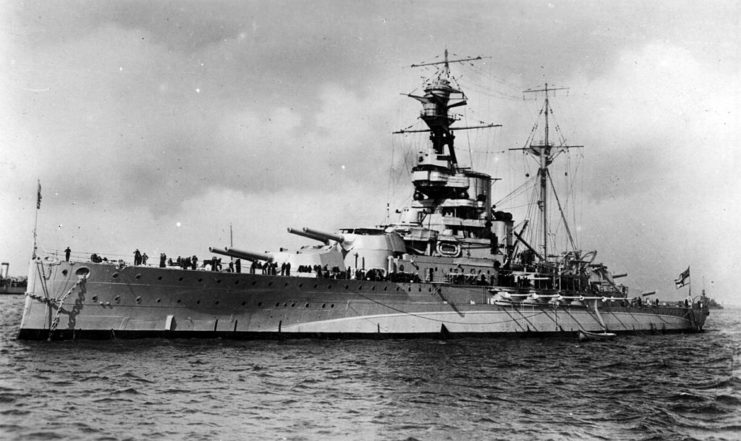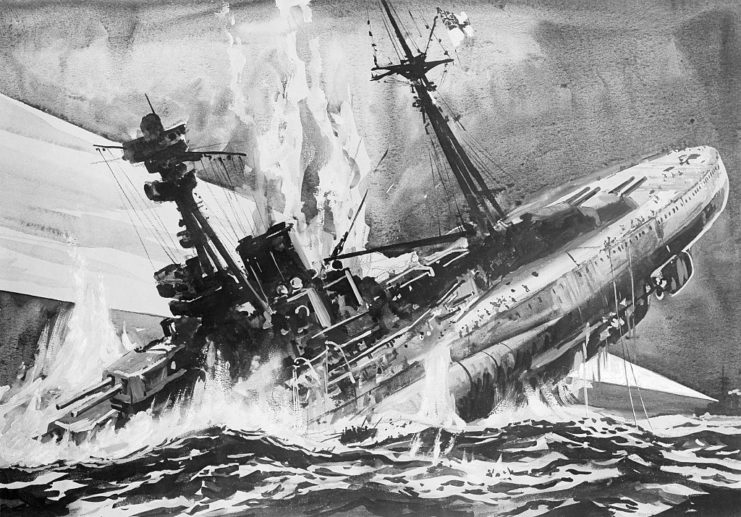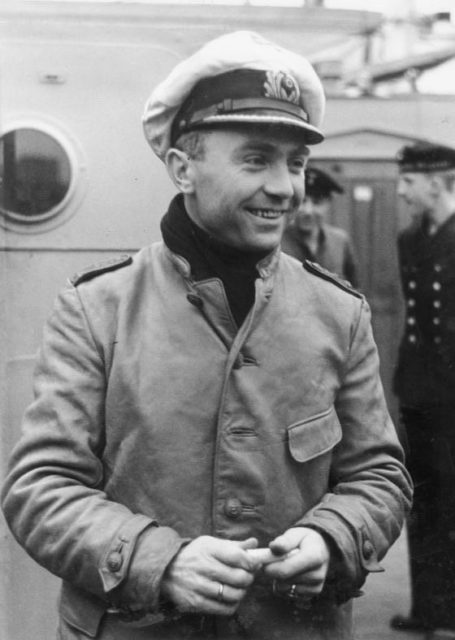Battleships were extremely important during the First World War, and the British Royal Navy had some of the most impressive vessels of the conflict. They were known for their advanced design and firepower. The HMS Royal Oak (08), one of just five ships in her class, is one of the most-fondly remembered from that era.
Design of the HMS Royal Oak

Construction of the HMS Royal Oak began in January 1914. She was one of five Revenge-class battleships built by the British Royal Navy and was the eighth ship to be given the name. The intention was for the class to be slower and smaller than previous battleships, but, at the same time, be more heavily protected than their predecessors in the Queen Elizabeth-class.
Royal Oak was over 620 feet long, and powered by two sets of Parsons steam turbines. At full capacity, the ship could hold around 909 officers and ratings. She had a range of 7,000 nautical miles, a cruising speed of around 11.5 MPH and a maximum speed of 26.5 MPH.
In terms of firepower, Royal Oak was equipped with eight breech-loading 15-inch Mk I guns within four twin gun turrets and 14 breech-loading six-inch Mk XII naval guns located in casemates and on the shelter deck. Four torpedo tubes were located on the broadsides, and the vessel’s anti-aircraft armament was made up of two quick-firing three-inch 20 cwt Mk I guns.
The Battle of Jutland

The HMS Royal Oak was almost immediately pressed into service during World War I. In May 1916, she was made a part of a group of ships tasked with bringing German vessels to battle. The plan was successful, and soon English and German ships faced off during the Battle of Jutland.
Royal Oak scored a hit on the German light cruiser SMS Wiesbaden during the fight. Soon after, the battleship was fired upon by a German salvo, but wasn’t damaged. While the battle continued, the British vessels eventually retreated from the area. Both sides claimed victory, but the actual results remain inconclusive.
Service during the interwar period

The HMS Royal Oak was assigned to the First Battle Squadron during the latter part of World War I. In August 1916, the Germans, led by Vice Adm. Reinhard Scheer, attempted to attack the British fleet unawares. However, the British forces had intercepted German transmissions and were able to score a decisive win.
After Germany capitulated, Royal Oak was anchored in Scapa Flow, a body of water near Scotland’s Orkney Islands, and heavily modernized during the early 1920s. This included upgrading her anti-aircraft weaponry and the addition of anti-torpedo bulges. She was, again, pressed into service during the Spanish Civil War. While Royal Oak conducted patrols, her commanders were told to not intervene, no matter the situation.
In 1937, the battleship became a movie star. Along with 14 other ships from the British fleet, she was featured in the film, Our Fighting Navy. Contrary to her role in World War I, Royal Oak was portrayed as a villainous vessel. The film captured her in perpetuity, but received poor reviews.
Sinking of the HMS Royal Oak

The HMS Royal Oak, along with many other ships in the British fleet, was kept at Scapa Flow. The area was ideal for larger-scale ships and was protected by a ring of islands. While there were protections against attacks from German U-boats, the submarines still presented a significant threat.
The Germans used air reconnaissance to develop a plan to attack Scapa Flow and noticed there were a number of pressure points they could take advantage of. Cmdr. Günther Prien was handpicked to lead the operation. Some 1,234 men were onboard Royal Oak when the attack occurred on October 14, 1939, of which 835 either died immediately or eventually succumbed to their injuries.
The German U-boat U-47 fired a number of torpedo salvos at Royal Oak during the attack, causing an explosion, which led the battleship to roll onto her side and sink.
The HMS Royal Oak‘s legacy

The aftermath of the sinking of the HMS Royal Oak was unusual. The battleship was not all that important, strategically, to Britain’s efforts during the Second World War. Still, the sinking of the vessel was devastating, morally. Günther Prien became somewhat of a celebrity in Germany and was dubbed the “Bull of Scapa Flow.”
More from us: The USS Forrestal (CV-59) Disaster Forever Changed the Way US Navy Sailors Learn Damage Control
Are you a fan of all things ships and submarines? If so, subscribe to our Daily Warships newsletter!
Today, the location where Royal Oak sank is considered a war grave and is marked by a buoy. The vessel remains in the same spot it was when it went down, some 100 feet below the surface. Each year, a White Ensign is placed at the battleship’s stern.
